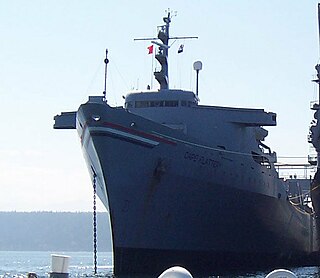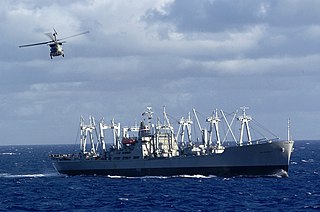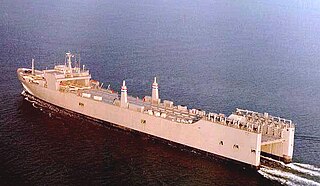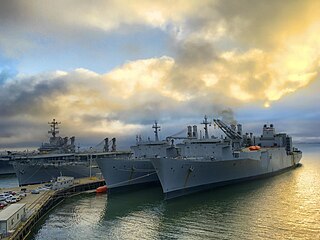
USS Cyrene (AGP-13) was a motor torpedo boat tender for the United States Navy. She was laid down as Cape Farewell, a Maritime Commission type (C1-A) hull under a Maritime Commission contract, at Pusey and Jones Corp., Wilmington, Delaware. Cyrene served in the Pacific from New Guinea to the Philippines from December 1944 to December 1945. The ship was decommissioned and placed in the Suisun Bay Reserve Fleet in July 1946 then withdrawn from the reserve fleet after sale to American Ship Dismantlers in December 1976.

USNS Comet (T-AK-269), later T-LSV-7, later T-AKR-7, later SS Comet, was a vehicle landing ship built for the United States Navy. The lone ship of her class, she was named for the comet, and was the fourth U.S. Naval vessel to bear the name.

USNS Sea Lift (T-LSV-9) was a roll on/roll off (Ro/Ro) cargo ship built for the United States Navy's Military Sea Transportation Service (MSTS), currently the Military Sealift Command (MSC). She became the first ship of Ro/Ro-type to deliver cargo to Vietnam during the war in Indochina.

The SS Cape Mohican (T-AKR-5065) is a steam turbine powered heavy-lift Seabee barge carrier, one of two ships of her type in the Military Sealift Command's Ready Reserve Force.
USNS Lt. James E. Robinson (T-AKV-3/T-AG-170/T-AK-274) was a U.S. Navy cargo ship, which was launched as a World War II commercial Victory ship SS Czechoslovakia Victory under the Emergency Shipbuilding program. She had earlier been the U.S. Army's USAT LT. James E. Robinson before being acquired by the U.S. Navy.

USS Pembina (AK-200) – later known as USNS Pembina (T-AK-200) -- was an Alamosa-class cargo ship that was constructed for the U.S. Navy during the closing period of World War II. She supported the end-of-war Navy effort and was subsequently placed in service with the US Army under the Shipping Control Authority for the Japanese Merchant Marine with a Japanese crew in Yokosuka, Japan.

SS Grand Canyon State (T-ACS-3) is a crane ship in ready reserve for the United States Navy. The ship was named for the state of Arizona, which is also known as the Grand Canyon State.

SS Keystone State (T-ACS-1) is a crane ship in ready reserve for the United States Navy. The ship was named for the state of Pennsylvania, which is also known as the Keystone State.

SS Gem State (T-ACS-2) is a crane ship in Ready Reserve for the United States Navy. The ship was named for the state of Idaho, which is also known as the Gem State.

SS Equality State (T-ACS-8) was a crane ship of the United States Navy. The ship was named for the state of Wyoming, which is also known as the Equality State. She was scrapped in June 2019.

SS Cape Flattery (AK-5070) was laid down on 10 February 1972, as SS Delta Norte a Maritime Administration type (C9-S-81d) hull under Maritime Administration contract at Avondale Industries Corp., New Orleans, LA. She was launched, 19 May 1973 and delivered to the Maritime Administration, 12 September 1973, for operation by Delta Line. She was reacquired by the Maritime Administration for assignment to the ready reserve fleet (RRF), 14 May 1987 and berthed at Beaumont, TX as part of the Maritime Administration Ready Reserve Fleet. When activated Cape Flattery is assigned to Military Sealift Command (MSC) as one of the Military Sealift Command's four LASH Ready Reserve Force Ships. Cape Flattery can be activated in 10 days

MV Cape Victory (T-AKR-9701) was built in 1984 as MV Marzario Britainna by Cant Nav. Italiani. After launching, it was delivered to CMB T. Italy for commercial operation. She was acquired. 2 April 1993, by the United States Department of Transportation, Maritime Administration and renamed MV Cape Victory on 2 April 1994 and assigned to the Maritime Administration's Ready Reserve Force, 19 August 1994. When activated Cape Victory is one of the Maritime Administration's 31 Roll-on/Roll-off Reserve Force Ships assigned to the US Navy's Military Sealift Command (MSC) Sealift Program Office. Cape Victory is nested at the National Defense Reserve Fleet in Beaumont, Texas, in ROS-5 status, with a 10-man maintenance crew on board.

SS Cape Florida (AK-5071) was laid down 29 December 1969, as SS LASH Turkiye, a United States Maritime Administration type (C8-S-81b) hull under Maritime Administration contract at Avondale Industries Corp., New Orleans. She was launched, 10 October 1970 and delivered to the Maritime Administration, 12 September 1973, for operation by Prudential Grace Line. She was acquired by Delta Line and initially renamed SS Delta Caribe and subsequently SS American Caribe. She was reacquired by the Maritime Administration for assignment to the Ready Reserve Fleet (RRF) on 17 February 1987 where she was berthed at Beaumont, Texas. When activated Cape Florida was assigned to the Military Sealift Command (MSC) as one of the Military Sealift Command's four LASH Ready Reserve Force Ships and could be activated in 10 days. She was removed from MSC control, withdrawn from the RRF by reassignment to the National Defense Reserve Fleet, 28 July 2006. On 6 July 2020 the contract for dismantling Cape Florida was awarded to International Shipbreaking Ltd. She arrived at Brownsville, Texas on 13 August of the same year to begin scrapping, with the process expected to be completed by early 2021.

USTS Kennedy(T-AK-5059), callsign KVMU, IMO number 6621662, is a former commercial freighter and a current training vessel of the United States Maritime Service.

SS Cape Gibson (AK-5051) was a Cape G Class Break bulk cargo ship of the United States Maritime Administration, last used as a training ship at Texas A&M University at Galveston before being scrapped in 2020.

SS Cape Girardeau is a Modular Cargo Delivery System (MCDS) ship in the National Defense Reserve Fleet. The ship is named for Cape Girardeau, Missouri.

Type C8-class ships are a type of Heavy Lift Barge Carrier. Type C8 ships were the 8th type of ship designed by the United States Maritime Commission (MARCOM) in the late 1960s. As done with the Type C1 ships and Type C2 ships, MARCOM circulated preliminary plans for comment. The design presented was not specific to any service or trade route. Type C8 ships measuring 876 feet (267 m) from stem to stern, and designed to make 16.2 knots.

Pacific Reserve Fleet, Alameda was a part of the United States Navy reserve fleets, also called a mothball fleet, that was used to store the many surplus ships after World War II. The Pacific Reserve Fleet, Alameda was part of the former Naval Air Station Alameda in Alameda, California, in the San Francisco Bay. Some ships in the fleet were reactivated for the Korean War and Vietnam War.

















